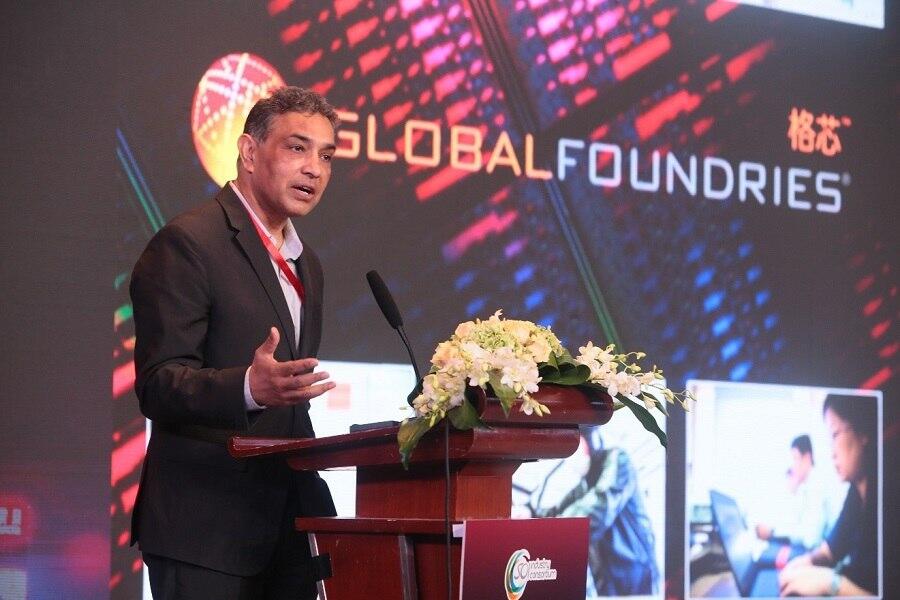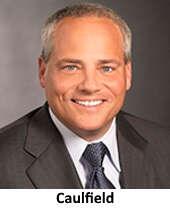GlobalFoundries Announces New CEO
Article By : Rick Merritt

Thomas Caulfield replaces Sanjay Jha after four years
SAN JOSE, Calif. — Sanjay Jha stepped down as chief executive of Globalfoundries after just four years on the job. Thomas Caulfield, an ex-IBM manager who runs GF’s Fab 8 in New York, has become the new CEO.
The change comes at a key inflection point for Globalfoundries. It needs to snag major customers for its fully depleted silicon-on-insulator (FD-SOI) process this year, and it will ramp its internally developed 7nm node, a potentially lucrative technology, but one about six months behind rival TSMC.
So far, Samsung and TSMC are both ahead of GF in leading-edge nodes and packaging technologies such as TSMC’s CoWoS, a 2.5D chip stack, and InFO, a wafer-level fan-out technique. Their lead helps them capture lucrative, high-volume business such as Apple’s A-series iPhone processors, now made by TSMC, and Qualcomm’s Snapdragon, made by Samsung.
Jha leaves to pursue other opportunities, including potentially starting systems businesses at the Mubadala Investment Company in the United Arab Emirates that owns GF. The company did not provide any details of what his new role will be at Mubadala, but said the transition had been in the works for some time and declined to make executives available for interviews.
Caulfield, the new CEO, is credited with getting GF’s Fab 8 into volume production of 14nm process technology. It is making the Ryzen and Epyc x86 processors driving AMD’s comeback as well as IBM’s z-series mainframe and Power 9 processors.

Caulfield spent 17 years at IBM in many roles, leading to serving as the head of its 300mm fab in East Fishkill, N.Y. After leaving IBM in 2005, he headed sales, service and marketing for four years at capital equipment supplier Novellus. Just prior to joining GF in May 2014, he was for two years the president and COO of Soraa, a developer of gallium nitride chips for solid-state lighting.
As a private company, GF does not reveal details of its finances or wafer production. A spokesman said GF has grown revenue and market share under Jha.
Market watcher IC Insights pegs GF as a distant second with 2017 revenues of $5.86 billion compared to TSMC at $32.2 billion. It ranks Samsung at fourth with $4.79 billion in 2017 sales, slightly behind UMC.
FD-SOI, China and EUV on the road map
Mubadala has no doubt made huge investments to expand GF’s fabs in Singapore, New York and Dresden — investments on which the new CEO will no doubt be under pressure to deliver a return. The company licensed its 14nm technology from Samsung, but developed its own 7nm process and plans to enhance it with extreme ultraviolet lithography over the next two years — systems with price tags of well over $100 million each.
To date, the company which started its life as the manufacturing division of AMD has announced only a few customers. They include Qualcomm for unnamed products and STMicroelectronics, which is a collaborator in its initiative on FD-SOI.
During Jha’s time at GF, the company acquired IBM’s chip manufacturing group. As part of that deal, it took on making IBM’s microprocessors as well as a relatively small but lucrative IBM foundry business in ASICs and RF for customers such as Skyworks.
GF reports it has more than 50 first-time-right tape outs at its Fab 8 which also makes 28nm chips. It has not yet announced any customers for its 7nm process expected to start ramping late this year.
This is a big year for GF’s entry into FD-SOI. It expects about 20 customer tape outs in the process this year in its Dresden fabs. To date, Samsung has been the source of some high-profile FD-SOI products such as NXP’s i.MX processors.
A year ago, GF struck a deal to build in Chengdu Province what it claims could be China’s most advanced 300mm fab. It will start off transferring older processes from GF’s Singapore fabs but ultimately aims to be a source for the FD-SOI process.
Jha came to GF after serving as CEO of Motorola Mobility, a struggling handset unit ultimately acquired and sold by Google. Prior to that he served 14 years at Qualcomm, the last two years as its COO.
In a press statement, a Mubadala representative who chairs GF’s board expressed willingness to continue its investments in GF. He gave no indications whether the change in leadership reflected possible disagreements over strategy between Jha and Mubadala.
“GF is a strategic asset for the global semiconductor industry and our shareholder. We will continue to invest to differentiate and grow the business and further consolidate the industry through partnerships, in a way that allows us to better serve our customers,” said Ahmed Yahia Al Idrissi, chairman of the GF board.
“Sanjay delivered on strategic milestones which set the company on the right path and we would like to thank him for his significant contributions. Tom, with his 25-year track-record of operational excellence and delivering for customers, will take the company to the next level of success,” he added in the press statement.
— Rick Merritt, Silicon Valley Bureau Chief, EE Times
Subscribe to Newsletter
Test Qr code text s ss


